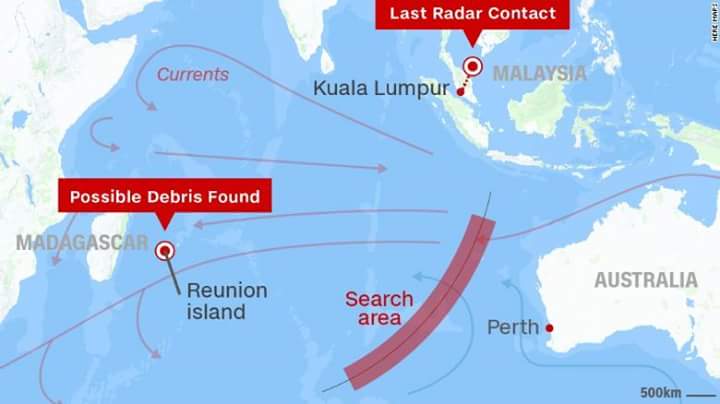BOEING777 : Still a mystery unsolve 😨😨😨
The official search for the missing Malaysia Airlines Flight MH370, which vanished on March 8 of 2014, has continued since September of that year in a stretch of the remote, southern Indian Ocean that investigators have identified as the most likely crash site for the Boeing 777.
But a new statistical analysis by mathematician Brock McEwen, examining ocean drift patterns in the region has found that the discovery of five pieces of debris believed to be part of the Malaysia Airlines plane indicate that Flight MH370 may not be where the searchers have been combing the ocean floor for the past 20 months — at a cost of nearly $70 million without finding a single trace of the plane.
A piece of the plane’s wing, known as a “flaperon” was discovered on Reunion Island in the western Indian Ocean in July of last year, and four more pieces of debris were discovered earlier this year on the coasts of Mozambique, Mauritius and South Africa, all in the same area of the Indian Ocean as Reunion.
But according to the McEwen study, if Malaysia Airlines Flight MH370 actually crashed in the location where the Australian Transportation Safety Board has been searching, additional debris should have also washed up on the shores of western Australia.
But no Flight MH70 debris has been found there.
“No matter how he changed the parameters, the result came back the same,” wrote science writer Jeff Wise on his blog, summarizing the highly technical McEwen study. “Debris should have washed up in Western Australia long before it washed up anywhere else.”
Wise is an independent MH370 researcher who has written frequently and served as a CNN commentator on the Malaysia Airlines mystery. Wise himself has recently raised questions about the apparent lack of marine life on the debris pieces. The absence of such growth could indicate that the debris was deliberately “planted,” Wise has argued.
See the link in the below “Previous Coverage” box for further details of Wise’s planted debris case.
The full Brock McEwen statistical study can be viewed by clicking on this link.
The following CBS News report details the latest discovery of possible Malaysia Airlines Flight MH370 debris.
The McEwen study follows a previous analysis conducted last Septenber by researchers at Gemany’s GEOMAR-Helmholtz Institute for Ocean Research, which came to similar conclusions.
That study, which used computer simulations to track two million separate debris patterns of objects in the Indian Ocean, found that for the flaperon to have reached Reunion Island, the plane must have crashed somewhere well to the north of the official search area.
GEOMAR Researcher Arne Biastoch told a German newspaper this week that the location of the newer debris findings support his team’s conclusions “perfectly.”
The ATSB based its conclusions about where the plane must have crashed based on the assumption that Malaysia Airlines Flight MH370 was flying blind, a “ghost ship” with no one at the controls, which simply flew until it ran out of fuel, then crashed.Wise also said that the new statistical analysis rules out the “pilot suicide” theory as well, because under that scenario the Malaysia Airlines pilot would have flown the plane even further south past the area that became the ATSB search zone.
Instead, someone at controls of Malaysia Airlines Flight MH370 turned the plane to the north for an unknown reason, raising the questions of who did it — and why?


If you like mysteries, then how about this - Flight MH370 goes mysteriously missing. Exactly 804 days later, EgyptAir flight #804 mysteriously disappears. Not a mention on the news about flight 804 missing 804 days after MH370. Hmm... nothing to see here folks.
Hi! I am a robot. I just upvoted you! I found similar content that readers might be interested in:
http://www.inquisitr.com/3050395/malaysia-airlines-flight-mh370-new-computer-analysis/